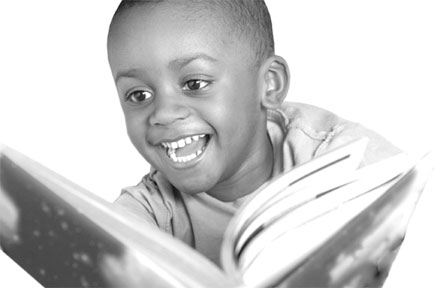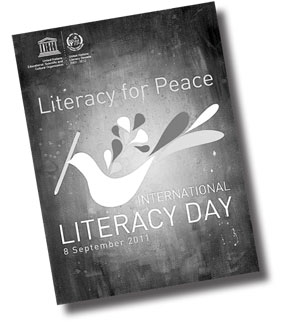|
 International Literacy Day on Thursday: International Literacy Day on Thursday:
Literacy and peace : An inseparable bond
By Pramod DE SILVA
You are reading this because, well, you can read. But 800 million
others around the world, nearly two-thirds of them women, cannot do
that. Yes, nearly one-seventh of humanity cannot read their own native
script. And that excludes the nearly 150 million children who have no
access to education.
If you cannot read, the window of knowledge is permanently closed for
you. Television and radio can only do so much as the bulk of our
knowledge is still in printed form. Even Internet access is of no use if
you cannot read. Countries are eager to open this window for their
illiterate citizens.
There is a day on which such efforts are highlighted and redoubled.
Called the International Literacy Day, it is traditionally observed
annually on September 8, focusing attention on worldwide literacy needs.
Why September 8? In September 1966 the World Conference of Ministers of
Education on the Eradication of Illiteracy was held in Tehran, Iran.
September 8, the opening date of the conference, was proclaimed
International Literacy Day.
The United Nations Educational, Scientific and Cultural Organization
(UNESCO) inaugurated its official observance of International Literacy
Day in 1967. The International Literacy Day is thus celebrated each year
on September 8. The aim of the day is to focus attention on the need to
promote worldwide literacy. On this day, individuals, organisations, and
all countries renew their efforts to promote literacy and demonstrate
their commitment to providing education for all.
 The International Literacy Day is celebrated under a special theme
every year. This year’s theme is Literacy for Peace, a highly
appropriate theme for a world torn apart by conflict. As UNESCO Director
General Irina Bokova notes in a message on the International Literacy
Day, peace and literacy are inseparable concepts. The International Literacy Day is celebrated under a special theme
every year. This year’s theme is Literacy for Peace, a highly
appropriate theme for a world torn apart by conflict. As UNESCO Director
General Irina Bokova notes in a message on the International Literacy
Day, peace and literacy are inseparable concepts.
Lifelong learning
"Lasting peace is founded on respect for human rights and social
justice. Literacy, the foundation of all education and lifelong
learning, is one of these rights. Literacy is a prerequisite for peace
because it carries multiple benefits, cutting across the human,
cultural, social, political and economic spheres. In today’s
knowledge-driven societies, lack of literacy is more than ever
synonymous with exclusion and marginalisation," the message says.
As she rightly points out, widespread illiteracy and lack of access
to education is an infringement of human rights and fundamental
freedoms, and a threat to peace and security.
After all, literacy is essential for individuals to effectively
participate in the democratic process.
For example, if one cannot read a leaflet given by a politician or
public representative or read his speech in the newspaper, that limits
his knowledge. If he cannot write about an issue facing his community to
the authorities, that limits his voice in society. That is the power of
literacy.
Being able to read and write gives anyone a bigger say in the affairs
of his or her country. Sri Lankans, working towards peace and
reconciliation at the end of three decades of strife, will also find
this year’s theme inspiring.
It is easier to establish lasting peace, building mutual trust
between citizens through inclusive education systems that promote mutual
understanding, respect, tolerance and dialogue. Sri Lanka’s achievements
in the field of literacy are creditable.
It has one of the highest literacy rates in Asia, but it should now
focus more on bilingual literacy. Indeed, the authorities are already
promoting the learning of each other’s language (Sinhala and Tamil) by
the country’s main communities.
If all Sinhala students can speak and read Tamil and if all Tamil
students can speak and read Sinhala, reconciliation will not be a
difficult task.

|
Literacy facts
* 800 million adults around the world cannot read
* More than half of those unable to read and write – 412 million –
live in Southern Asia. A further 176 million adults are in sub-Saharan
Africa. Together, these two regions account for three-quarters (74
percent) of adults unable to read and write worldwide.
* Gender disparity was greatest in Southern Asia, where 73 percent of
all men but only 51 percent of women have the ability to read and write.
Teaching mothers to read can lead to a decrease in infant mortality of
up to 50 percent.
* Ninety eight percent of all non-literates live in developing
countries. 52 percent of all non-literates live in India and China.
* Africa as a continent has a literacy rate of less than 60 percent.
* In all developing countries, the percentage of children aged 6-11
not attending school is 15 percent. In the least developed countries, it
is 45 percent.
* The global adult literacy rate is 83 percent, with a male literacy
rate of 88 percent and a female literacy rate of 79 percent.
|
One should not forget that the child soldiers deployed by the LTTE
had no access to education at all and their rehabilitation essentially
includes a literacy aspect. The same principle applies to public
servants. They will gain an insight into each other’s culture and
traditions. Publications in either language will not be alien to anyone.
Ideal foundation
A truly bilingual (or trilingual, with English) society is the ideal
foundation for lasting peace and reconciliation. This is why UNESCO has
called for literacy programs that strengthen mutual understanding by
enabling people to share ideas and express, preserve and develop their
cultural identity and diversity.
It is crucial to integrate literacy in the peace-building process.
One example of the intricate link between peace and literacy has been
provided by Burundi’s National Literacy Service, the recipient of one of
the two King Sejong Literary Prizes this year which gives special
consideration to the creation, development and dissemination of mother
tongue languages in developing countries. The National Literacy Service
in Burundi has been honoured for its innovative approach in linking
literacy not only to daily life issues, but also to peace and tolerance.
Burundi is still recovering from a long period of civil war which
fractured its population. Census figures for 2008 show 57.5 percent of
the population in Burundi (three million people) are illiterate, of
which 61 percent are women.
The National Literacy Service has addressed these problems as part of
its vast literacy program by creating courses open to and accessible by
all, regardless of gender, ethnicity, religion or region, and where
teachers are trained to help the different groups brought together in
the classroom towards reconciliation.
Literacy courses
The program’s courses, which began in 1989, take place in more than
900 centres across the country and are delivered in the national
language, Kirundi. As a result of the program at least 20,000 people are
becoming literate each year. From 2010 to 2011, the program awarded more
than 50,000 certificates to new readers and figures from this year show
19,897 people following literacy courses in the country.
 “Literacy has encouraged reconciliation between populations separated
by war. Meetings in the literacy courses have brought the two camps
together and cleared the atmosphere of mistrust,” says Program Director
Prime Hakiza. “Literacy has encouraged reconciliation between populations separated
by war. Meetings in the literacy courses have brought the two camps
together and cleared the atmosphere of mistrust,” says Program Director
Prime Hakiza.
The other winner of the prize, Mexico’s National Institute of
Education of Adults, has undertaken a similar Bilingual Literacy for
Life project focusing on Spanish and an indigenous language (out of 40)
depending on the area. These two examples show the inter-relationship
between peace and literacy.
At the end of the day, literacy is not about reading big books per
se. It is more about being able to do some simple things like writing
your name and address in a form and reading the ‘stop’ sign on the
expressway. But books do remain at the pinnacle of the literary trail.
Even though paper books are gradually giving way to digital versions
through gadgets such as the iPad and the Kindle, the ‘printed’ word will
remain king. Books encapsulate what we know about our world and literacy
helps to unlock this treasure trove.
The silver lining about the e-readers is that they could attract a
new gadget-loving generation to reading and thus help raise literacy
levels.
In the future, reading will be as easy as A-B-C to a highly literate
technology driven generation.
|

